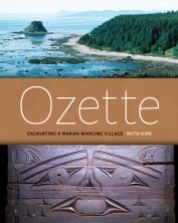News
The Washington Center for the Book at The Seattle Public Library announces the finalists in eight categories for the 2016 Washington State Book Awards for outstanding books published by Washington authors in 2015. Congratulations to our finalists Ana Maria Spagna (Reclaimers; Biography/Memoir) and Ruth Kirk (Ozette; History/General Nonfiction). The winners in each category will be announced at the awards ceremony on October 8, 2016. Emcee for the evening is Frances McCue, twice a UW Press finalist for a WSBA (in 2011 for The Car That Brought You Here Still Runs and in 2015 for Mary Randlett Portraits). The awards celebration is free and open to the public.
 University of Washington Press shares in the remembrance of Sarah Reichard, who died suddenly in her sleep on August 29, 2016. Dr. Reichard directed the University of Washington Botanic Gardens, was coeditor of Invasive Species of the Pacific Northwest, and advised UW Press on other projects. Read obituaries and details on the October 13th memorial celebration in the Seattle Times and Offshoots (blog of the UW School of Environmental and Forest Sciences).
University of Washington Press shares in the remembrance of Sarah Reichard, who died suddenly in her sleep on August 29, 2016. Dr. Reichard directed the University of Washington Botanic Gardens, was coeditor of Invasive Species of the Pacific Northwest, and advised UW Press on other projects. Read obituaries and details on the October 13th memorial celebration in the Seattle Times and Offshoots (blog of the UW School of Environmental and Forest Sciences).
Reviews and Interviews
Michael Upchurch reviews Looking for Betty MacDonald by Paula Becker in the Seattle Times: “The Egg and I, The Plague and I and Anybody Can Do Anything practically cavort off the page. How did [Betty MacDonald] do it? Seattle author Paula Becker has some answers in her compact, finely crafted biography.”
Lory Widmer Hess reviews the biography on her Emerald City Book Review blog: “I was delighted to explore MacDonald’s life and work through Paula Becker’s thoughtful, painstakingly researched biography, and even more thrilled to see that University of Washington Press is going to be reprinting three hard-to-find later works by the bestselling author of The Egg and I: Anybody Can Do Anything, The Plague and I, and Onions in the Stew. . . . If you’re not a MacDonald enthusiast, you will be soon. . . . We can be grateful that Becker has preserved it for us in words, and has given us valuable insights into her world, her books, her family, and the writer herself.”
Barbara McMichael reviews in the Kitsap Sun: “The pages zing with unexpected detail and nuggets of lacerating wit. . . If you’re Looking for Betty MacDonald, you need look no further.” Paula’s other book (The Alaska-Yukon-Pacific Exposition) and the MacDonald reissues (The Plague and I, Anybody Can Do Anything, and Onions in the Stew) also get mentions.
Steve Donoghue reviews the books at Open Letters Monthly: “A smart and immensely readable portrait, taking readers through MacDonald’s life. . . . Becker has combed every interview and profile, and her book veritably glows with MacDonald’s recaptured wit. . . . Thanks to Paula Becker’s exhaustive research and the compassionate, standard-setting book she’s shaped out of it, 21st century readers can meet a much fuller and more fascinating version of that complex, challenging, laughing woman. Readers of her books will still want to thank her, but thanks to Looking for Betty MacDonald, they’ll know her much better.” The Plague and I (“improbably funny. . . equally remarkable”) and Anybody Can Do Anything (“again improbably funny”) also get mentions.
Bainbridge Community Broadcasting’s “What’s Up Bainbridge” host Wendy Wallace speaks with Paula Becker about the biography and reissues.
Continue reading











 Paula Becker‘s
Paula Becker‘s 